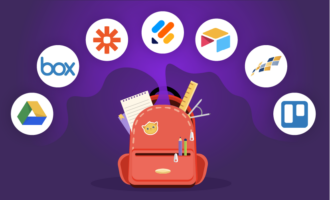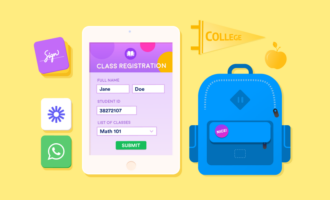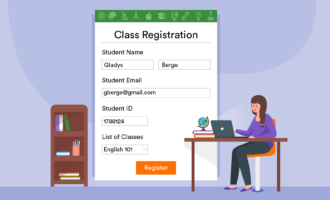Blended learning is a hybrid approach to teaching that combines face-to-face instruction with technology-assisted learning. This hybrid learning method has been around for a while, whether it involves students accessing tablets in the classroom or using a computer to complete an assignment at home. But with newer technology and digital education tools like webinars, video conferencing, games, simulations, and more, blended learning has expanded, and it can feel like a whole new world of teaching.
The pandemic may have accelerated the adoption of the blended learning approach, but the powerful benefits it delivers mean it’s likely here to stay.
An overview of blended learning and why it’s important
Blended learning, sometimes referred to as hybrid learning, combines traditional in-classroom teaching methods like face-to-face instruction with digital learning resources and online components. These include webinars, on-demand videos, online access to course materials, and interactive elements like quizzes, simulations, chat rooms, and more.
Blended learning’s mixture of synchronous and asynchronous elements allow students to learn and study at their own pace, providing greater flexibility and leading to improved learning and comprehension.
As teachers had to transition to remote learning during the COVID-19 pandemic, blended learning became an integral part of education. Teachers and administrators soon discovered that, far from being a Band-Aid for a temporary problem, this hybrid form of education offers better access and more opportunities for both students and teachers.
7 benefits of blended learning
Here are a few ways blended learning benefits students and educators:
1. Serves students of all abilities
Blended learning creates an integrated classroom environment that allows students with different learning styles to stay engaged and motivated. Students can learn at a pace that works for them.
2. Increases engagement, learning, and retention
Several studies have shown that a variety of modalities, such as those common in blended learning (face-to-face instruction, video conferencing, online quizzes, threaded discussions, and more), result in higher engagement and retention and provide better opportunities for collaborative learning.
3. Saves money
With its reliance on technology and digital tools, blended learning can reduce or eliminate the cost of printed educational materials and textbooks, as teachers can streamline and condense course content into web-based learning.
4. Enhances efficiency
The technology teachers use in blended learning automates tasks like taking attendance, grading assignments, and printing and organizing handouts. And that means teachers can spend less time outside the classroom on administrative chores and more time helping students learn. That’s a bonus for everyone!
5. Helps students succeed
The tracking and analytics capabilities of blended learning tools allow educators to gather data on student engagement, class attendance, learning comprehension, test scores, and more. Teachers can use this data to identify individual students’ learning gaps and analyze areas for improvement to help them succeed. It also helps teachers identify where to make adjustments to course materials overall.
6. Offers more flexibility
When teachers deliver online instruction and course materials both synchronously and asynchronously, they create a flexible learning environment for their students. Some students may work more effectively with face-to-face instruction in a classroom setting, while others may benefit more from doing work asynchronously on their own. Making both options available gives each student access to the modality that best suits their learning style.
7. Provides better reach and accessibility
Using blended learning tools makes course content easily accessible on demand to all students, regardless of their learning needs, including students who use assistive devices such as speech synthesizers, screen readers, speech recognition programs, alternative keyboards, and more. And because much of the learning is delivered online, educators can increase the number of students they reach.
Traditional, in-person instruction, combined with digital tools that complement and enhance the face-to-face classroom experience create a powerful blended learning environment – one that benefits students and teachers across the learning spectrum.
Pro Tip
Boost engagement in your blended learning sessions with Jotform Presentation Agents. Try them today to create interactive presentations that captivate your students and enhance their learning experience.
Resources to support blended learning
Jotform offers an array of effective tools to support blended learning, including free online quiz templates; a selection of education-related table templates to help you stay organized and keep student information in one secure, easily accessible place; and fully customizable online education form templates.
We also offer drag-and-drop form-building functionality, form integrations to take your online forms to the next level, and security features that include 256-bit SSL, encryption, spam protection, and more.
In addition to our numerous free resources, Jotform has special pricing plans just for educators.
Get started with our data collection tool today, and receive a 50 percent educational discount for any paid plan. With the discount, the Bronze plan, which includes 25 forms and 1,000 monthly submissions, is just $17 per month. The Silver plan is $19.50 per month and includes 50 forms and 2,500 monthly submissions, and the Gold plan is $49.50 per month and includes 100 forms and 10,000 monthly submissions.
We also offer a 30 percent discount to educational institutions through Jotform Enterprise. Jotform Enterprise is highly secure and customizable, allowing you to create a comprehensive school management platform that fits your needs.
Photo by Julia M Cameron







































































































Send Comment: